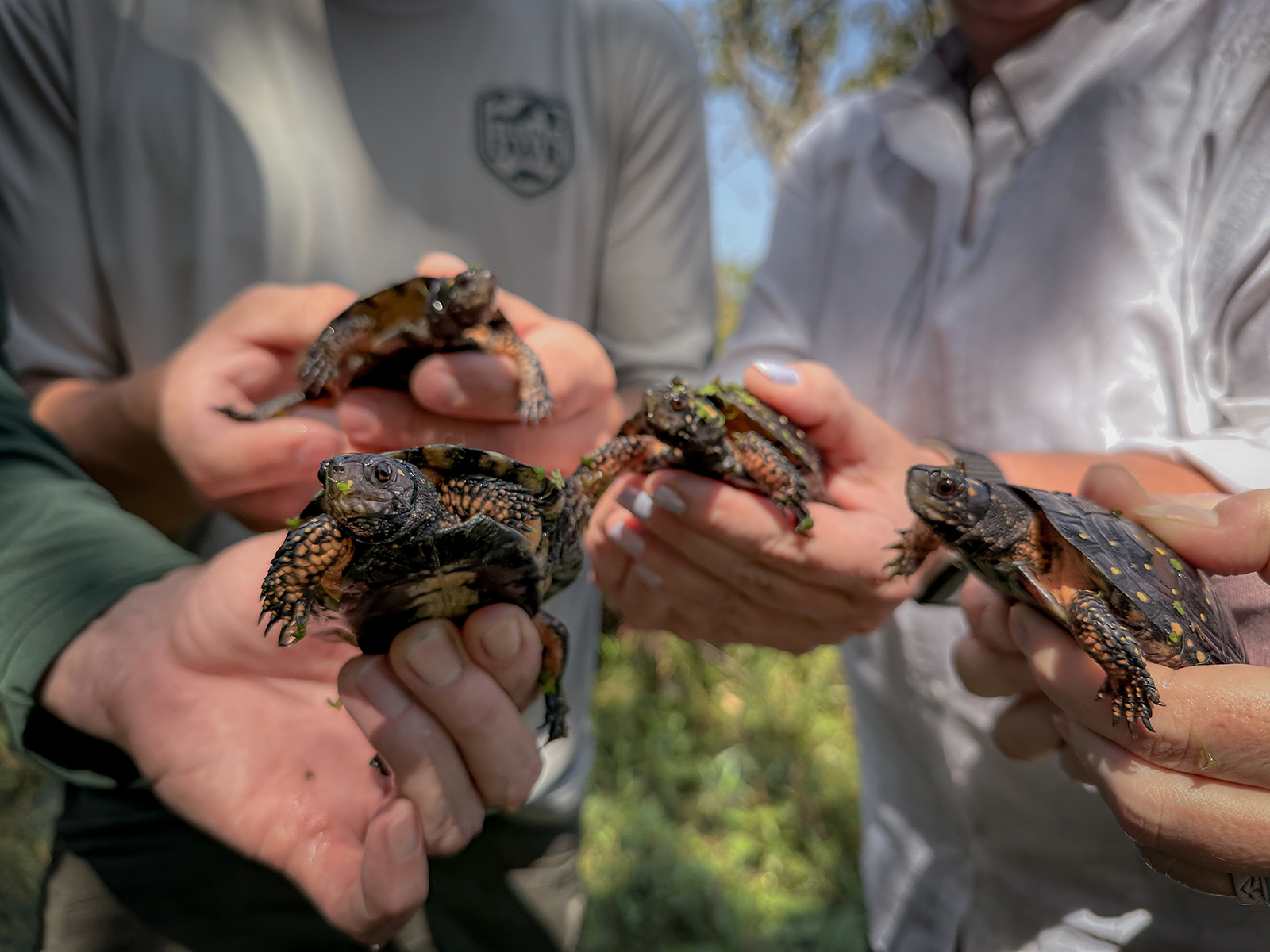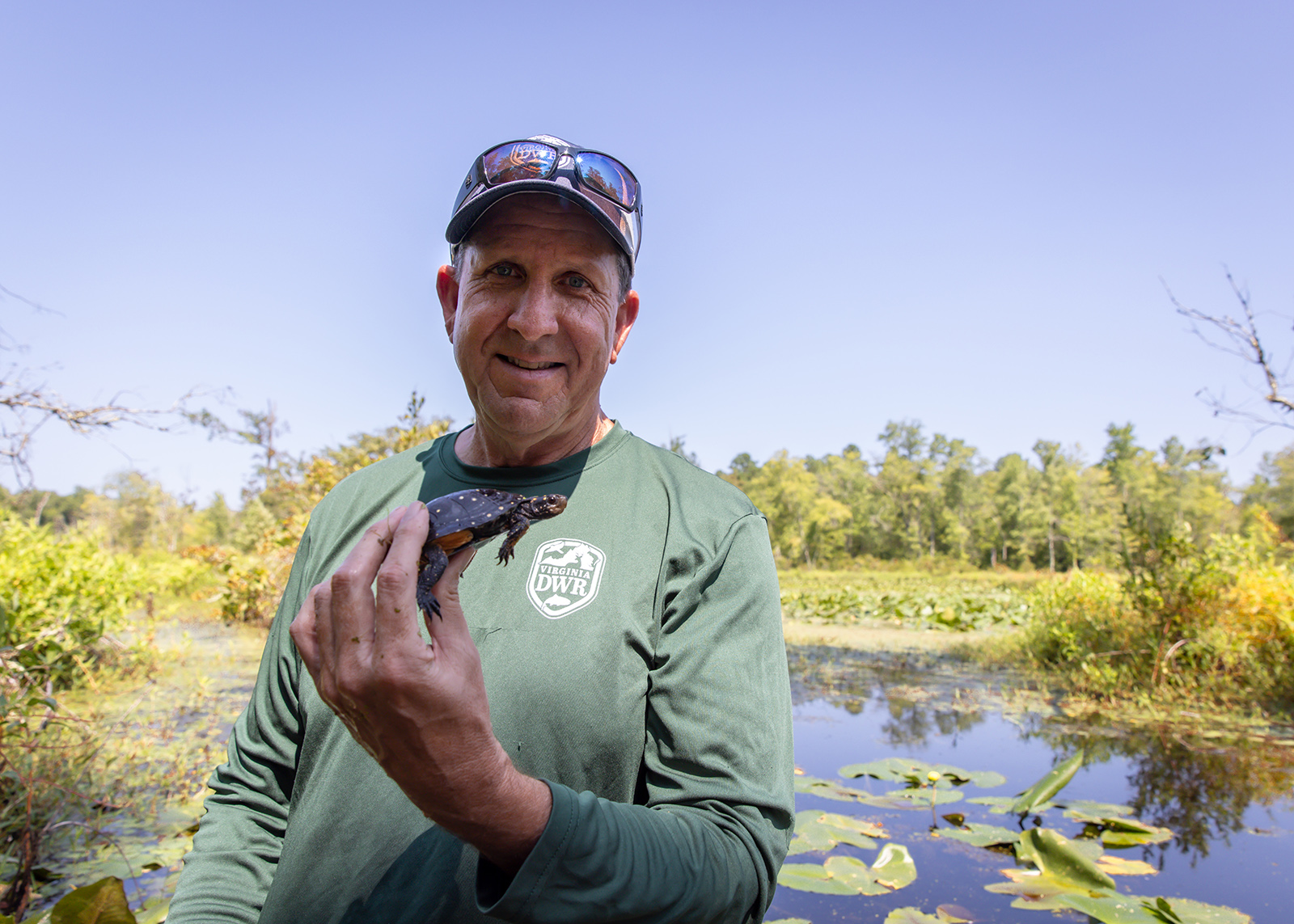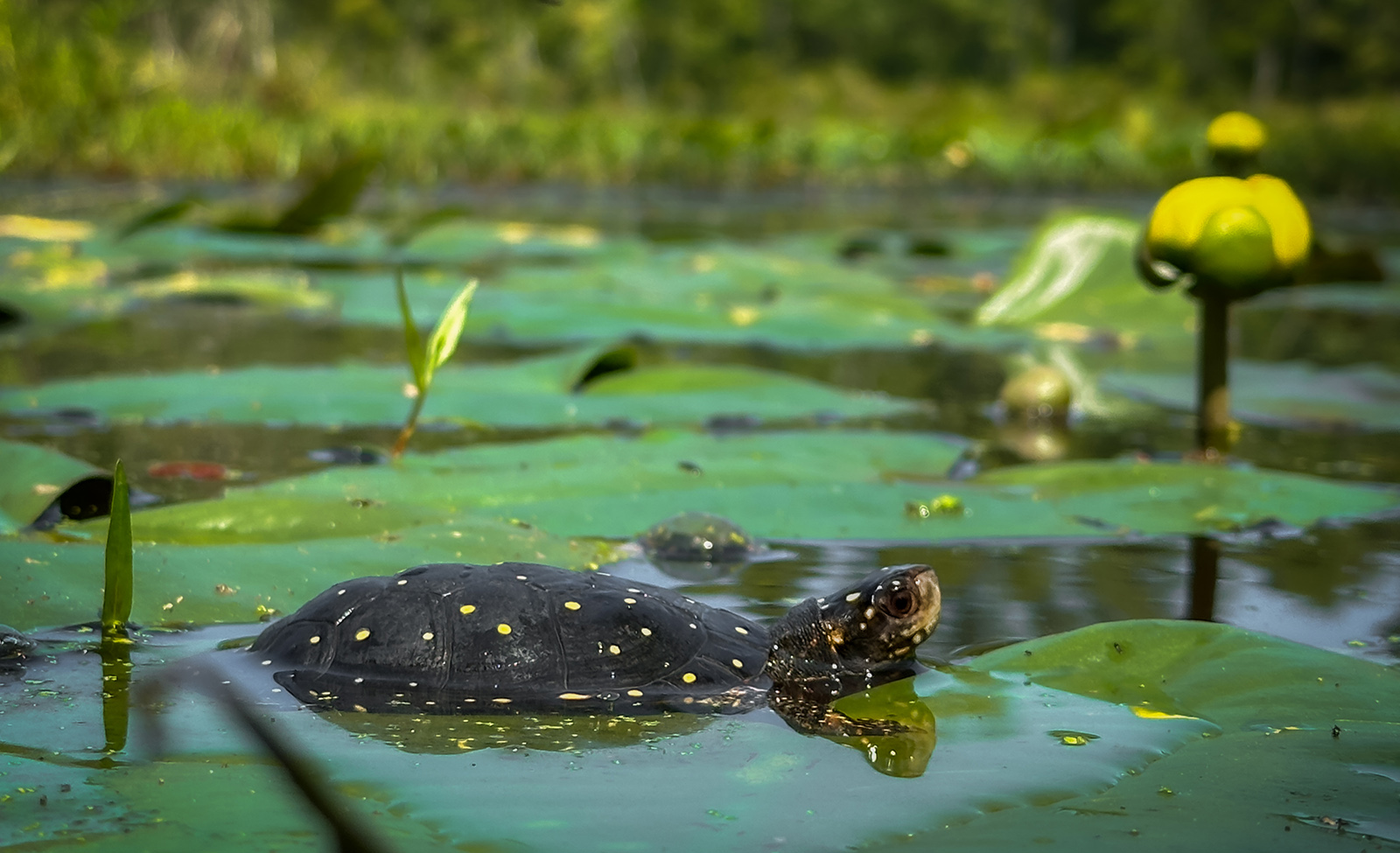Eight spotted turtles have returned to the wild in Virginia thanks to genetic testing and a protocol that could help reshape the future of confiscated turtles.
By Molly Kirk/DWR
Photos by Meghan Marchetti/DWR
It had been at least six years since these turtles had roamed freely and been able to paddle around a pond. As they quietly splashed into the shallows in a central Virginia wetland area, the small group of people watching smiled. It was a good day for these eight spotted turtles—a day when years of captivity and an uncertain fate ended and their return to the wild began. Years of work by dedicated conservationists and the innovative use of genetic testing made it all possible.
“This was very rewarding to see,” said Virginia Department of Wildlife Resources (DWR) State Herpetologist J.D. Kleopfer. “This was years of work that finally had a great end result. It may not seem like a lot—it’s eight turtles—but we hope it’s just the tip of the iceberg. Because there are hundreds of other turtles waiting to be assigned and returned to the wild. And we’re hoping that we can take this recipe, so to speak, and be able to apply it to future confiscations.”

In 2018, these eight spotted turtles (Clemmys guttata) were part of a large confiscation by the New York Department of Environmental Conservation (DEC), where 292 animals were seized from an individual’s house, saving them from the illegal pet trade pipeline. Of the 292 animals, 184 were spotted turtles.
According to Kleopfer, spotted turtles, a Species of Greatest Conservation Need in Virginia, are a popular species for illegal pet trade collectors to poach and eventually send abroad for sale. “They’re small, they’re showy, and they’re personable turtles,” Kleopfer said. “Unfortunately, a lot of the areas that get targeted are public lands, like refuges, because that’s where they probably have the healthiest, largest, most robust populations of spotted turtles. Unfortunately, on public lands is where you tend to get a lot of illegal activities. It’s easy enough to be hiking around with a backpack, and nobody would think twice about you. Whereas on private land it’s a different story.”
Read more about the illegal turtle trade in the article Shell Game, originally published in the May/June 2021 issue of Virginia Wildlife magazine.
When turtles are recovered from the illegal pet trade, they can’t just be released anywhere due to concerns about disease transmission and keeping genetic populations intact. In fact, it’s illegal to relocate or liberate turtles in Virginia. Hundreds of turtles can be saved from the pet trade, but they can’t be returned to the wild. “A lot of times when people hear about these things—300 turtles were confiscated—the actual confiscation makes a lot of news, but the story kind of ends there,” Kleopfer said. “But that’s just the beginning for those animals. Then there’s this long, drawn-out process of holding the animals and trying to figure out what you’re going to do with them afterward.”
For years, the spotted turtles were held by different institutions. The Turtle Survival Alliance was essential in helping place the turtles in appropriate facilities. “The next process was to really start looking at the genetics, determining where those turtles had come from,” said Dave Collins, senior director of domestic operations at the Turtle Survival Alliance. “That became quite a protracted affair, largely because of Covid.” The Turtle Survival Alliance’s AZA SAFE Program focuses on five imperiled species of North American turtles, including the spotted turtle, and works to develop a pathway for confiscated turtles to contribute to effective conservation efforts.

While the turtles were waiting, Kleopfer and wildlife biologists from 12 other Eastern Seaboard states were coordinating on a Competitive State Wildlife grant from the U.S. Fish and Wildlife Service that involved genetic testing of wild spotted turtles to create a genetic map of their populations. So, when the DNA of the seized New York spotted turtles was analyzed, their locations of origin could be determined. And these eight were identified as being from a Virginia location. “Fortunately, spotted turtles aren’t very genetically diverse, which means it wasn’t as critical to try to get them back to the exact location,” Kleopfer said.
“When we finally received the genetic assignments of the group and could see where they all came from, the process was to get in touch with the state biologist from each of the states that had animals assigned to those states,” said Collins. “In Virginia’s case, there seemed to be a very strong genetic assignment to a specific area that [Kleopfer] was very familiar with, and so it led to a very good outcome of identifying exactly where those turtles should be returned to.” So, in June, the eight turtles arrived at The Wildlife Center of Virginia (WCV) for some final preparations for their return to the wild.
“Our role was basically to make sure that they were clinically healthy, both in terms of their overall health and assessing them for potential diseases that they may be carrying,” said Connor Gillespie, director of outreach at WCV. “There are four standard diseases that we test for—mycoplasma, ranavirus, adenovirus, and herpes—just to make sure that they’re not carriers so that when they’re released back to the wild, they’re not going to put the local population that’s already out there at risk. Fortunately, all of the turtles tested negative, and no other medical issues were found, so we just made sure that they stayed well hydrated and got the proper nutrition and diet until release.”

DWR’s J.D. Kleopfer holding one of the spotted turtles released back to the wild in Virginia.
And in August, Kleopfer arrived to transport the spotted turtles to their new home. He admitted that as he watched them clamber over logs and swim away, he felt “more melancholy than excited,” Kleopfer said. “It was sad because somebody poached them out of Virginia, but at the same time exciting to see these eight animals make it back. Unfortunately, there are probably a number of turtles that were poached that will never make it back.”
Kleopfer is hopeful that this genetic testing and disease screening process will help biologists solve the problem of how to connect confiscated turtles saved from the pet trade with their original homes. “There are still a lot of other animals being held by zoos and other institutions, and hopefully they can take the same process and apply it to those turtles, and then hopefully start repatriating more turtles,” he said. “There were some box turtles that didn’t go through this exact same process, but they were repatriated by West Virginia. There were also some wood turtles that were being held by New Jersey that were repatriated as well. It was 10 years that those animals had been in captivity. We’re hoping that this will be the template for moving forward and getting more turtles back out on the landscape.”



